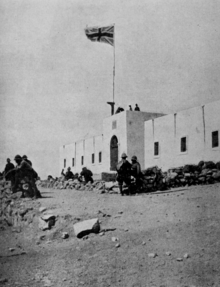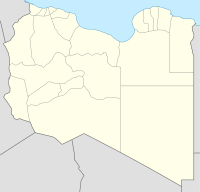Bir Hakeim rescue
| Bir Hakeim rescue | |||||||
|---|---|---|---|---|---|---|---|
| Part of the Senussi campaign | |||||||
 Bir Hakeim (red) and Sollum (blue) on a 1916 British map | |||||||
| |||||||
| Belligerents | |||||||
|
|
| ||||||
| Commanders and leaders | |||||||
|
| |||||||
| Strength | |||||||
| 45 vehicles | Senussi guards | ||||||
| Casualties and losses | |||||||
| None | |||||||
Bir Hakeim, the site of an Ottoman fort built around a Roman well | |||||||
The Bir Hakeim rescue (Arabic: بئر حكيم, romanized: biʾr ḥakīm, lit. 'Wise Well' pronounced [biʔr ħaˈkiːm] ) was a British raid in Italian Cyrenaica (modern Libya) on 17 March 1916 to recover prisoners of war held by the Senussi. Following the capture of Sollum on 14 March the British discovered evidence that the prisoners, survivors from two ships sunk by a German U-boat, were being held at the Bir Hakeim oasis, about 99 mi (160 km) to the west.
A rescue force of armoured cars and ambulances was assembled by Major Hugh Grosvenor, 2nd Duke of Westminster. The force, starting before dawn, drove across the desert and surprised the Senussi guards. On finding the prisoners had been half-starved during their 135 days' captivity the British pursued the fleeing Senussi and massacred most of them, including women and children. The party then returned to Sollum.
Background
The Allies and the Central Powers had been engaged in the First World War since 1914. As Caliph of the Islamic faith, the Ottoman Sultan, Mehmed V had some influence over the Senussi, Bedouin pastoralists of Italian Libya and the western portion of British Egypt. The Senussi were inspired to revolt against the colonial powers in November 1915 and occupied part of the coast and oases of the Sahara Desert, starting the Senussi campaign. The British formed the Western Frontier Force (WFF, Major-General William Peyton) to fight the Senussi. From February the British were reinforced by troops freed by the evacuation of Gallipoli.[1]
The British defeated the main Senussi force on the coast at the Action of Agagia on 26 February but parts of the coast to the west and the oases in the interior remained under Senussi control.[1] On 14 March the British re-occupied Sollum on the coast, to the west of Agagia, near the Libyan border. A mobile force, the Light Armoured Car Brigade (Major Hugh Grosvenor, 2nd Duke of Westminster), had played an important part, being directed in its movements by aircraft.[2] Westminster's force consisted of three batteries of Rolls-Royce Armoured Cars, equipped with powerful engines and a revolving machine gun turret.[3]
Prelude

When the British re-occupied Sollum, by a stroke of luck, a letter sent by Captain R. S. Gwatkin-Williams, the commander of Tara, to Sollum when he was ignorant that the British had withdrawn from the town, was found in a house. The contents of the letter indicated the whereabouts of the survivors of the crews of the armed boarding steamer Tara (formerly TSS Hibernia) and the horse transport HMT Moorina, ships sunk by a German U-boat in the Mediterranean in November 1915.[4] The WFF intelligence officer, Captain Leopold Royle, questioned the Senussi prisoners and established that the crews of the ships were at Bir Hakeim.[5]
Bir Hakeim was the name of the site of two Roman wells, a tomb and an Ottoman blockhouse about 120 mi (190 km) west of Sollum.[5] The Bir (well) did not appear on British maps but two Arab guides with the British claimed to know its location. Westminster and Peyton decided on a rescue attempt. Royle had knowledge of the area from his pre-war service with the Egyptian Coastguard and knew that the first 50 mi (80 km) of the desert was traversable by motor car.[6] Westminster gathered a force of 45 vehicles for the raid.[2] The vehicles comprised nine armoured cars, plus his Rolls Royce touring car and a number of un-armoured trucks and Ford ambulances.[7][6][8]
Rescue
Departing from Sollum at around 3.00 a.m. on 17 March, the group made the first part of the journey by moonlight.[4][8][2] The party made fast progress despite the going varying from soft sand to ground with many boulders.[5] With the assistance of the guides, the party reached Bir Hakeim around 12 hours later, having covered 120 mi (200 km).[6] The Senussi guards were surprised and fled, pursued by two of the cars. An armoured car driver, Sam Rolls, who wrote of the event in his 1937 memoir Steel Chariots in the Desert, stated that the British were shocked by the sight of the prisoners, whose 135 days of half-starvation in captivity had left them "living skeletons", and took vengeance on the Senussi.[3] He describes the cars shooting down men, women and children with only two babies surviving.[9] The British official historian, George Macmunn, wrote in 1928 that the prisoners had suffered some ill-treatment but had not been treated badly given the local customs.[10]

Macmunn wrote that the lack of food was unsurprising given the famine that was engulfing the Senussi. Four of the prisoners had died, mainly due to hunger and the survivors had suffered from illness, dysentery, lice and effects of the hot days and cold nights.[10] The party loaded the 92 surviving prisoners into the trucks and ambulances and returned to British-held territory.[2][a] The party arrived in Sollum 22 hours after they had left, having covered 250 mi (400 km).[9] The British force suffered no casualties and described the raid as having proceeded "without incident".[9] The rescued prisoners were sent to Alexandria for treatment before being returned to Britain.[11]
Aftermath
The historian Charles Stephenson, writing in 2014, said the raid could not have been achieved by any means available at the time except for the armoured cars. Westminster was appointed to the Distinguished Service Order for his work in the raid.[2] Fighting in the Senussi campaign continued at the oases of the interior until February 1917 when a victory by a British force equipped with armoured cars at the Siwa Oasis ended Senussi resistance.[12]
Notes
References
- ^ a b Macmunn & Falls 1996, pp. 119–134.
- ^ a b c d e Stephenson 2014, p. 225.
- ^ a b Reese 2022, p. 153.
- ^ a b Burg & Purcell 2010, p. 106.
- ^ a b c d Macmunn & Falls 1996, p. 133.
- ^ a b c Williams 2013, p. 24.
- ^ Macksey 1983, p. 16.
- ^ a b Hadaway 2014, p. 156.
- ^ a b c Smith & Cowman 2017, p. 194.
- ^ a b Macmunn & Falls 1996, pp. 133–134.
- ^ Jones 2012.
- ^ Macmunn & Falls 1996, pp. 135–153.
Bibliography
- Burg, David F.; Purcell, L. Edward (12 September 2010). Almanac of World War I. University Press of Kentucky. ISBN 978-0-8131-2745-3.
- Hadaway, Stuart (1 October 2014). Pyramids and Fleshpots: The Egyptian, Senussi and Eastern Mediterranean Campaigns, 1914–16. The History Press. ISBN 978-0-7509-5808-0.
- Jones, Geraint (1 February 2012). Anglesey at War. The History Press. ISBN 978-0-7524-9023-6.
- Macksey, Kenneth (1983). A History of the Royal Armoured Corps and Its Predecessors, 1914–1975. Newtown Publications. ISBN 978-0-9508536-0-4.
- Macmunn, G; Falls, C. (1996) [1928]. Military Operations: Egypt and Palestine, From the Outbreak of War with Germany to June 1917. History of the Great War Based on Official Documents By Direction of the Historical Section of the Committee of Imperial Defence. Vol. I (facs. repr. Imperial War Museum Department of Printed Books and Battery Press, Nashville, TN ed.). London: HMSO. ISBN 978-0-89839-241-8.
- Reese, Peter (12 May 2022). Sir Henry Royce: Establishing Rolls-Royce, from Motor Cars to Aero Engines. The History Press. ISBN 978-1-80399-081-1.
- Smith, Angela K.; Cowman, Krista (3 February 2017). Landscapes and Voices of the Great War. Taylor & Francis. ISBN 978-1-351-85641-6.
- Stephenson, Charles (19 December 2014). A Box of Sand: The Italo-Ottoman War 1911–1912. Tattered Flag. ISBN 978-0-9576892-7-5.
- Williams, Claud (19 November 2013). Light Car Patrols 1916–19: War and Exploration in Egypt and Libya with the Model T Ford. Silphium Press. ISBN 978-1-900971-15-7.

